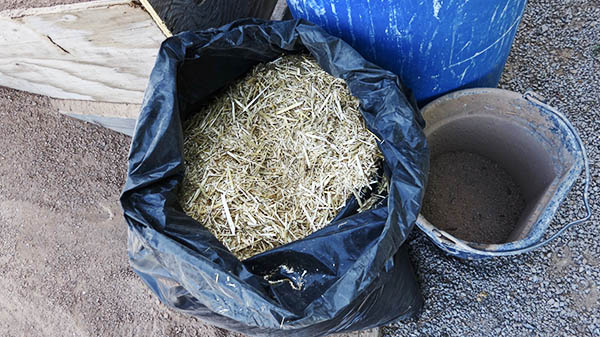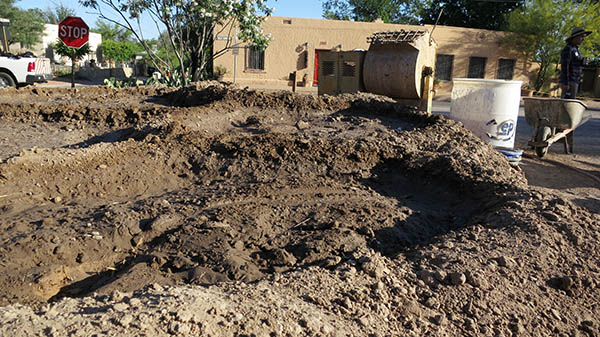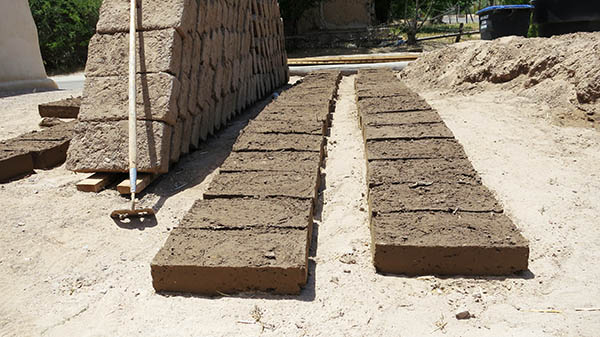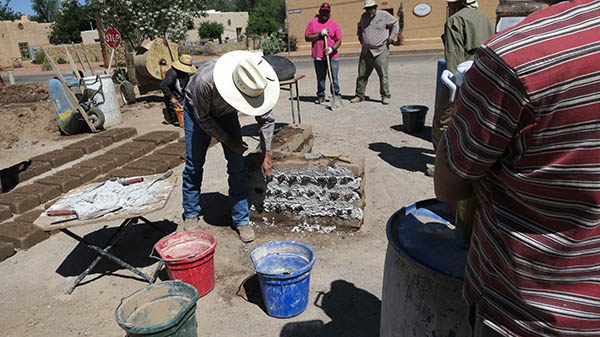 It takes 60 shovelfuls to fill the adobe mixer. Originally designed for mortar, the outside drum of our mixer looks like an inverted lunar landscape. Dimples as large as a quarter, back when a quarter was worth 25 cents, protrude far enough to run afoul of the mixer’s I-beam chassis. It’s the rocks, see? Mixing adobe eats up the rubber wiper blades on the paddles and as the gap between the blade and the drum grows larger things start going south. When the gap grows large enough the mixer paddles wedge into the rocks and a sharp pop, like someone hit the machine with a 16-pound sledgehammer, is followed by a lurch of the heavy machine. Another dimple has been created. If the conditions are just right the mixer blades will lock up solid and it takes a quick hand on the clutch lever to prevent a smoking V-belt.
It takes 60 shovelfuls to fill the adobe mixer. Originally designed for mortar, the outside drum of our mixer looks like an inverted lunar landscape. Dimples as large as a quarter, back when a quarter was worth 25 cents, protrude far enough to run afoul of the mixer’s I-beam chassis. It’s the rocks, see? Mixing adobe eats up the rubber wiper blades on the paddles and as the gap between the blade and the drum grows larger things start going south. When the gap grows large enough the mixer paddles wedge into the rocks and a sharp pop, like someone hit the machine with a 16-pound sledgehammer, is followed by a lurch of the heavy machine. Another dimple has been created. If the conditions are just right the mixer blades will lock up solid and it takes a quick hand on the clutch lever to prevent a smoking V-belt.
I’m telling you this now because when the machine is running it’s so loud conversation is impossible. Big Pappy and I are mixing mud and filling wheel buggies with adobe for blocks. Pappy’s arms are as big around as my legs. Those protruding dimples rubbing the chassis make rotating the hopper to dump mud a two-man operation. We push so hard we nearly tip the machine on its side. Big Pappy nods, which I take to mean push harder. It doesn’t. The handle slams Pappy upside the head and he gives me a murderous look. “What the hell are you doing? I told you to stop.” I’ve only been on the job an hour and I’m already injuring my coworkers.
 With adobe mixing the show must go on so Pappy and I work in silence. Not total silence though, because we have to keep count of how many shovels we are throwing into the hopper. “I’m at 13,” I tell Pappy. “15” for me, Pappy replies. The mixer locks up, I grab the clutch. We move loaded buggies to the block-making area then we shovel more dirt into the hopper. Soon the injury is forgotten. “Is that good?” “More water.” Pappy says. “4 more shovelfuls.” “Ok, that’s good. Let’s let it mix” Pappy feels bad about yelling at me, I feel bad for hurting Pappy. We are a team again. I’ve got to be more careful working around others.
With adobe mixing the show must go on so Pappy and I work in silence. Not total silence though, because we have to keep count of how many shovels we are throwing into the hopper. “I’m at 13,” I tell Pappy. “15” for me, Pappy replies. The mixer locks up, I grab the clutch. We move loaded buggies to the block-making area then we shovel more dirt into the hopper. Soon the injury is forgotten. “Is that good?” “More water.” Pappy says. “4 more shovelfuls.” “Ok, that’s good. Let’s let it mix” Pappy feels bad about yelling at me, I feel bad for hurting Pappy. We are a team again. I’ve got to be more careful working around others.
Buggies full of the sticky clay, sand and straw mixture that makes up an adobe block are dumped into 2-block forms and smoothed by hand. We have plenty of willing helpers because this is a New Mexico Humanities Council program created to teach the traditional ways of adobe construction (nmhumanities.org). After 2 full days of class a student will come away with a sore back and respect for the ones that came before.
We make adobe block after adobe block. Pat Taylor, our maestro of mud has more than a little Tom Sawyer in him as he makes the hard work of mixing and pouring adobe seem like fun. Several hundred blocks later we have filled up much of the parking lot. After a month of baking in the sun the blocks will be so hard that it takes a solid blow from a hammer to fracture them.
 “Who wants to give it a try?” Pat asks and several would-be adobe builders jump in and start laying blocks. Instead of cement mortar, more mud is used to set the Adobe blocks. I’m cutting a bevel into the blocks to create a space for small volcanic rocks. The rocks are fitted into the bevels and held in with a white lime mortar. Once these protruding rocks are set the lime plaster will adhere to the rocks, hopefully keeping the plaster from sloughing off the wall.
“Who wants to give it a try?” Pat asks and several would-be adobe builders jump in and start laying blocks. Instead of cement mortar, more mud is used to set the Adobe blocks. I’m cutting a bevel into the blocks to create a space for small volcanic rocks. The rocks are fitted into the bevels and held in with a white lime mortar. Once these protruding rocks are set the lime plaster will adhere to the rocks, hopefully keeping the plaster from sloughing off the wall.
Amazingly, we make a pretty decent looking wall. The lime plaster hides all manner of sin and if you can keep the rain off of your adobe wall the thing will last several centuries.
 There’s another, even older method of finishing adobe walls borne from necessity: More mud. Mud plaster doesn’t last as long as lime plaster but if you don’t have lime what’s a poor boy to do? Think of mud plaster as a sacrificial coating. It erodes so that the adobe blocks underneath don’t. Mud plaster is applied by hand or trowel, and re-applied every few years as needed. As Pat’s students, we got to try all application methods with special emphasis on the difficult ones.
There’s another, even older method of finishing adobe walls borne from necessity: More mud. Mud plaster doesn’t last as long as lime plaster but if you don’t have lime what’s a poor boy to do? Think of mud plaster as a sacrificial coating. It erodes so that the adobe blocks underneath don’t. Mud plaster is applied by hand or trowel, and re-applied every few years as needed. As Pat’s students, we got to try all application methods with special emphasis on the difficult ones.
The mortar, the blocks, the plaster, everything except the lime was made from a mixture of clay, sand and straw. Only the ratios varied depending on what you were using it for. And they didn’t vary all that much. Adobe uses the simplest building material, dirt, and combines it with human muscle to fashion living spaces. It’s the oldest building material yet adobe techniques will likely see use in future human settlements anywhere dirt is plentiful, the land is inhospitable and a Home Depot is far, far away.

****German soldier hiding behind a fern****”Very interesting……”
Big Pappy is wearing a pink shirt, top center of the wall photo. You don’t want him mad at you.
The volcanic rocks are strange thing it’s an interesting scenario